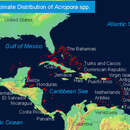Biology
provided by Arkive
Like many corals, staghorn corals have a special symbiotic relationship with algae, called zooxanthellae. The zooxanthellae live inside the tissues of the coral and provide the coral with food, which it produces through photosynthesis and therefore requires sunlight. In return, the coral provides the algae with protection and access to sunlight.
Staghorn corals are reef-building or hermatypic corals, and are incredibly successful at this task for two reasons. Firstly, they have light skeletons which allow them to grow quickly and out-compete their neighbouring corals. Secondly, the skeleton, or corallite, of a new polyp, is built by specialised 'axial' corallites. These axial corallites form the tips of branches, and as a result, all the corallites of a colony are closely interconnected and can grow in a coordinated manner (2).
Staghorn corals reproduce sexually or asexually. Sexual reproduction occurs via the release of eggs and sperm into the water. Most staghorn corals on the Great Barrier Reef sexually reproduce simultaneously, an incredible event that occurs soon after the full moon, from October to December. Streams of pinkish eggs are released from corallites on the sides of branches, to be fertilized by sperm released from other polyps at the same time. The water turns milky from all the eggs and sperm released from thousands of colonies. Some of the resulting larvae settle quickly on the same reef, whilst others may drift around for months, finally settling on reefs hundreds of kilometers away (2). Asexual reproduction occurs via fragmentation, when a branch breaks off a colony, reattaches to the substrate and grows (3).
Conservation
provided by Arkive
Staghorn corals are listed on Appendix II of the Convention on International Trade in Endangered Species (CITES), and therefore trade in this coral should be carefully regulated, and a permit is required to bring the coral, or objects made from them, into the countries that have signed the CITES convention (1). Staghorn corals will also form part of the marine community in many marine protected areas, or in areas where management plans are in place to protect the coral community. In some areas, coral reefs restoration attempts are being undertaken; in Florida Keys National Marine Sanctuary, efforts have been made to reattach coral fragments, or culture and settle coral larvae. Both activities have had limited success, and new techniques are being pursued (4).
Description
provided by Arkive
Staghorn corals are among the fastest growing corals on reefs, and are excellent reef-builders (2). The name Acropora literally means a porous stem or branch (3), but Acropora species express a much greater variety of growth forms than the name suggests. Colonies can resemble antlers (staghorns) and be up to two meters tall, or can form delicately engineered plates and tables that may be up to three meters across. They can also form bush-like structures, some with short non-dividing branches like the fingers of a hand (2). Staghorn corals often out-compete all other corals in shallow tropical reefs, however, their speed of growth (which can be up to 10 to 20 centimetres a year (4)) is balanced by the fragility of some of the structures, as they are easily damaged in storms allowing other coral species a chance of growth. With 368 Acropora species currently known, and with such an amazing array of shapes, sizes and colours, identifying individual species can be a tricky task (2).
Habitat
provided by Arkive
Staghorn corals occur in tropical reef environments, down to a depth of 30 meters. The upper depth limit is defined by wave action, whilst the lower limit at which Acropora can inhabit is determined by light availability and the amount of suspended sediments. Staghorn corals require normal marine salinity (4).
Range
provided by Arkive
This is the most abundant coral of most reefs in the Indo-Pacific (2), and three species also occur in the western Atlantic and Caribbean region (3).
Status
provided by Arkive
Listed on Appendix II of CITES (1).
Threats
provided by Arkive
Staghorn corals face the many threats that are impacting coral reefs globally. At present, around one third of the world's reef-building corals are threatened with extinction. The principal threat to corals is the rise in sea temperature associated with global climate change. This leads to coral bleaching, where the symbiotic algae are expelled, leaving the corals weak and vulnerable to an increasing variety of harmful diseases. Climate change is also expected cause more extreme weather incidents and to increase ocean acidification, which impairs the coral's ability to form a skeleton. These global threats are compounded by localised threats from pollution, destructive fishing practices, invasive species and human development (5).
Staghorn corals are considered to be environmentally sensitive corals that require clear, well-circulated water. Unlike other corals, which can obtain nourishment from zooplankton, staghorn corals are almost entirely dependent on the zooxanthellae for food. This means that sunlight is essential, and they are particularly sensitive to any human activities that increase water turbidity, reducing light availability (3).
Two of the three Acropora species in the Atlantic were once very abundant, but in recent decades have remained at low levels of abundance, with no signs of recovery and in some areas, continued decline. These species are believed to be most greatly threatened by disease, temperature-induced bleaching, and physical damage from hurricanes. Threats from anthropogenic physical damage (e.g. vessel groundings, anchors, divers, snorkelers), coastal development, competition and predation are deemed to be moderate. The threat from collection or harvest was deemed abated by effective national and international regulations (3).
Acropora species constituted 13 percent of the global coral trade between 1985 and 1997. Coral is harvested for building materials, curios, jewellery, and for aquariums. Staghorn corals are more common in the dead coral trade, rather than the live aquarium trade (6).

